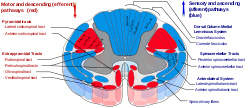This article needs additional citations for verification .(September 2014) |
| Extrapyramidal system | |
|---|---|
 Medulla spinalis. (Extrapyramidal tracts are labeled as a group in red, at bottom left.) | |
| Details | |
| Identifiers | |
| Latin | systema extrapyramidale |
| NeuroNames | 2070 |
| Anatomical terms of neuroanatomy | |
In anatomy, the extrapyramidal system is a part of the motor system network causing involuntary actions. [1] The system is called extrapyramidal to distinguish it from the tracts of the motor cortex that reach their targets by traveling through the pyramids of the medulla. The pyramidal tracts (corticospinal tract and corticobulbar tracts) may directly innervate motor neurons of the spinal cord or brainstem (anterior (ventral) horn cells or certain cranial nerve nuclei), whereas the extrapyramidal system centers on the modulation and regulation (indirect control) of anterior (ventral) horn cells.